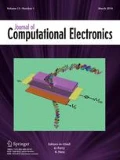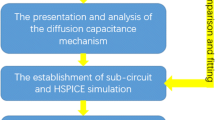Abstract
In this paper, we simulate the electrical characteristics of the n-type metal-oxide-semiconductor (NMOS) transistor in a 65-nm complementary metal-oxide-semiconductor (CMOS) inverter under the actions of heavy ions with different linear energy transfers (LET). We analyze the influence of incident ions with different LETs on a device using technology computer-aided design (TCAD) software, and aim to establish an HSPICE sub-circuit model containing the relationship between the electrical properties of a device and the LET of an incident ion for circuit-level HSPICE simulation. Based on the SEE funnel mechanism, we propose an analytical model to describe the relationship between the charge collected by the NMOS drain and the LET of the incident ion, and build an HSPICE model based on this analytical model. With such a model, the influence of incident ions with different circuit-level LETs can be determined from HSPICE simulation. In addition, good agreement with simulation results is reached, proving the reasonableness of the proposed model.











Similar content being viewed by others
References
Autran, J.L., Glorieux, M., Munteanu, D., Clerc, S., Gasiot, G., Roche, P.: Particle Monte Carlo modeling of single-event transient current and charge collection in integrated circuits. Microelectron. Reliab. 54, 2278–2283 (2014)
Sterpone, L., Du, B., Azimi, S.: Radiation-induced single event transients modeling and testing on nanometric flash-based technologies. Microelectron. Reliab. 55, 2087–2091 (2015)
Ferlet-Cavrois, V., Massengill, L.W., Gouker, P.: Single event transients in digital CMOS—a review. IEEE Trans. Nucl. Sci. 60(3), 1767–1790 (2013)
Zhang, Z., Liu, J., Hou, M., Gu, S., Liu, T., Zhao, F., Geng, C., Xi, K., Sun, Y., Yao, H., Luo, J., Duan, J., Mo, D., Liu, G., Han, Z.: Investigation of threshold ion range for accurate single event upset measurements in both SOI and bulk technologies. IEEE Trans. Nucl. Sci. 61(3), 1459–1467 (2014)
Chen, C.-H., Knag, P., Zhang, Z.: Characterization of heavy-ion-induced single-event effects in 65 nm bulk CMOS ASIC test chips. IEEE Trans. Nucl. Sci. 61(5), 2694–2701 (2014)
Chen, Y.: Minghua Tang study on single event effect mechanism and hardened techniques of field effect transistor. Xiangtan University, Hunan (2016)
Qin, J., Chen, S., Guo, C., Du, Y.: Simulation study of the single-event effects sensitivity in nanoscale CMOS for body-biasing circuits. IEEE Trans. Dev. Mater. Reliab. 14(2), 639–644 (2014)
He, Y.B., Chen, S.M.: Impact of circuit placement on single event transients in 65 nm bulk CMOS technology. IEEE Trans. Nucl. Sci. 59(6), 2772–2777 (2012)
Heidel, D.F., Rodbell, K.P., Oldiges, P., Gordon, M.S., Tang, H.H.K., Cannon, E.H., Plettner, C.: Single-event-upset critical charge measurements and modeling of 65 nm silicon-on-insulator latches and memory cells. IEEE Trans NuclSci 53(6), 3512–3517 (2006)
Osowski, A.J.K., Oldiges, P., Williams, R.Q., Solomon, P.M.: Modeling single-event upsets in 65-nm silicon-on-insulator semiconductor devices. IEEE Trans. Nucl. Sci. 53(6), 3321–3328 (2006)
Balasubramanian, A., Fleming, P.R., Bhuva, B.L., Amusan, O.A., Massengill, L.W.: Effects of random dopant fluctuations (RDF) on the single event vulnerability of 90 and 65 nm CMOS technologies. IEEE Trans. Nucl. Sci. 54(6), 2400–2406 (2007)
Wissel, L., Heidel, D.F., Gordon, M.S., Rodbell, K.P., Stawiasz, K., Cannon, E.H.: Flip-flop upsets from single-event-transients in 65 nm clock circuits. IEEE Trans. Nucl. Sci. 56(6), 3145–3151 (2009)
Zhao, Y., Wang, L., Yue, S., Sun, Y., Wang, D., Liu, L., Liu, J., Wang, H.: Single event effect and its hardening technique in nano-scale CMOS integrated circuits. Acta Electron. Sin. 46(10), 2511–2518 (2018)
Liu, J., Wang, Y., Chen, G., Li, R., Li, Y., Fu, D.: Modeling of single event pulse with VerilogA: implementation and application. In: Nanoelectronics Conference, pp. 1–2 (2016)
Privat, A., Clark, L.T.: Simple and accurate single event charge collection macro modeling for circuit simulation. In: IEEE International Symposium on Circuits and Systems, pp. 1858–1861 (2015)
Black, D.A., Robinson, W.H., Wilcox, I.Z., Limbrick, D.B., Black, J.D.: Modeling of single event transients with dual double-exponential current sources: implications for logic cell characterization. IEEE Trans. Nucl. Sci. 62(4), 1540–1549 (2015)
MacSweeney, D., McCarthy, K.G., Mathewson, A., Mason, B.: A SPICE compatible subcircuit model for lateral bipolar transistors in a CMOS process. IEEE Trans. Nucl. Sci. 45(9), 1978–1984 (1998)
Kauppila, J.S.: Layout-aware modeling and analysis methodologies for transient radiation effects on integrated circuit electronics. Graduate School of Vanderbilt University, Nashville, Tennessee (2015)
Geng, C., Liu, J.: Modeling and Evaluating the Single Event Upset by Theoretical and Computational Simulation in Micro/Nano Scale SRAMs. The University of Chinese Academy of Sciences, Lanzhou (2014)
VisualTCAD 1.7.2: VisualTCAD User’s Guide Cogenda Pte Ltd. Su Zhou, China (2017)
Laux, S.E., Hess, K.: Revisiting the analytic theory of p–n junction impedance: improvements guided by computer simulation leading to a new equivalent circuit. IEEE Trans. Electron. Dev. 46(2), 396–412 (1999)
Yi, T., Liu, Y., Yang, Y.: A study of PN junction diffusion capacitance of MOSFET in presence of single event transient. J. Electron. Test. 33(6), 769–773 (2017)
HSPICE User Guide: Basic Simulation and Analysis. Synopsys, California (2013)
Keith, W.: Golke determination of funnel length from cross section versus LET measurements. IEEE Trans. Nucl. Sci. 40(6), 1910–1917 (1993)
Acknowledgements
This research was partially supported by the National Defense Foundation of China. The authors are grateful for the software support provided by Cogenda Pte Ltd.
Funding
Project supported by National Defense Foundation of China (No. 41424050607).
Author information
Authors and Affiliations
Corresponding author
Additional information
Publisher's Note
Springer Nature remains neutral with regard to jurisdictional claims in published maps and institutional affiliations.
Supplementary Information
Below is the link to the electronic supplementary material.
Rights and permissions
About this article
Cite this article
Xu, C., Yi, T., Liu, Y. et al. LET-dependent model of single-event effects in MOSFETs. J Comput Electron 20, 1496–1503 (2021). https://doi.org/10.1007/s10825-021-01713-8
Received:
Accepted:
Published:
Issue Date:
DOI: https://doi.org/10.1007/s10825-021-01713-8




